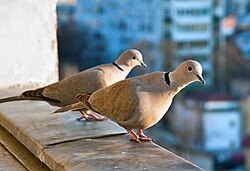Eurasian collared-dove
| Eurasian collared dove | |
|---|---|
 |
|
| Streptopelia decaocto | |
| Scientific classification | |
| Kingdom: | Animalia |
| Phylum: | Chordata |
| Class: | Aves |
| Order: | Columbiformes |
| Family: | Columbidae |
| Genus: | Streptopelia |
| Species: | S. decaocto |
| Binomial name | |
|
Streptopelia decaocto (Frivaldszky, 1838) |
|
 |
|
The Eurasian collared dove (Streptopelia decaocto), most often simply called the collared dove, also sometimes hyphenated as Eurasian collared-dove, is a species of dove native to warm temperate and subtropical Asia, and introduced in North America in the 1980s.
Collared doves are sometimes kept in aviculture, and form strong relationships with each other.
The genus name Streptopelia is from Ancient Greek streptos, "collar" and peleia, "dove". The specific decaocto is a latinisation of the Greek word for "eighteen", from deca, "ten", and octo, "eight". In Greek mythology, a servant complained bitterly about pay of just 18 pieces a year, and the gods changed her to a dove that still cries mournfully.
It is a medium-sized dove, distinctly smaller than the wood pigeon, similar in length to a rock pigeon but slimmer and longer-tailed, and slightly larger than the related turtle dove, with an average length of 32 cm (13 in) from tip of beak to tip of tail, with a wingspan of 47–55 cm (19–22 in), and a weight of 125–240 g (4.4–8.5 oz). It is grey-buff to pinkish-grey overall, a little darker above than below, with a blue-grey under wing patch. The tail feathers are grey-buff above, and dark grey tipped white below; the outer tail feathers also tipped whitish above. It has a black half-collar edged with white on its nape from which it gets its name. The short legs are red and the bill is black. The iris is red, but from a distance the eyes appear to be black, as the pupil is relatively large and only a narrow rim of reddish-brown iris can be seen around the black pupil. The eye is surrounded by a small area of bare skin, which is either white or yellow. The two sexes are virtually indistinguishable; juveniles differ in having a poorly developed collar, and a brown iris.
There are two subspecies, Streptopelia decaocto decaocto in most of the range (including all of the 20th century colonisations), and Streptopelia decaocto xanthocyclus in the southeast of the range from Burma east to southern China. The latter differs in having yellow skin around the eye (white in the nominate subspecies). Two other subspecies formerly sometimes accepted, Streptopelia decaocto stoliczkae from Turkestan in central Asia, and Streptopelia decaocto intercedens from southern India and Sri Lanka, are now considered synonyms of S. d. decaocto.
...
Wikipedia

